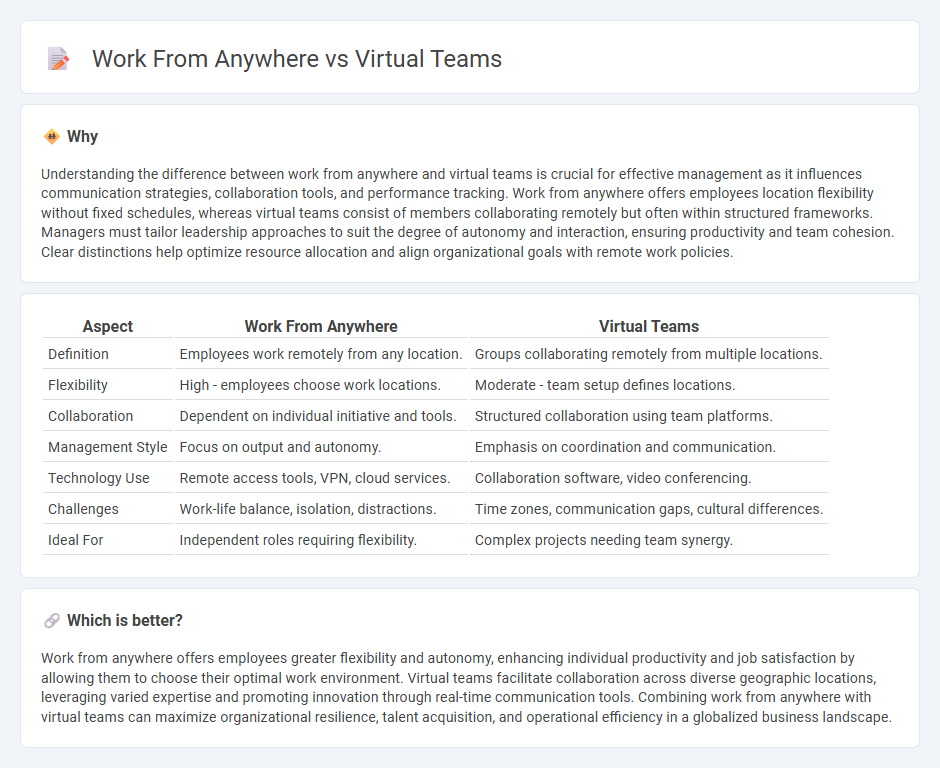
Work from anywhere policies empower employees to perform tasks outside traditional office settings, leveraging digital tools to maintain productivity. Virtual teams consist of geographically dispersed members collaborating through technology to achieve common goals without physical co-location. Explore how these concepts reshape organizational management and team dynamics.
Why it is important
Understanding the difference between work from anywhere and virtual teams is crucial for effective management as it influences communication strategies, collaboration tools, and performance tracking. Work from anywhere offers employees location flexibility without fixed schedules, whereas virtual teams consist of members collaborating remotely but often within structured frameworks. Managers must tailor leadership approaches to suit the degree of autonomy and interaction, ensuring productivity and team cohesion. Clear distinctions help optimize resource allocation and align organizational goals with remote work policies.
Comparison Table
| Aspect | Work From Anywhere | Virtual Teams |
|---|---|---|
| Definition | Employees work remotely from any location. | Groups collaborating remotely from multiple locations. |
| Flexibility | High - employees choose work locations. | Moderate - team setup defines locations. |
| Collaboration | Dependent on individual initiative and tools. | Structured collaboration using team platforms. |
| Management Style | Focus on output and autonomy. | Emphasis on coordination and communication. |
| Technology Use | Remote access tools, VPN, cloud services. | Collaboration software, video conferencing. |
| Challenges | Work-life balance, isolation, distractions. | Time zones, communication gaps, cultural differences. |
| Ideal For | Independent roles requiring flexibility. | Complex projects needing team synergy. |
Which is better?
Work from anywhere offers employees greater flexibility and autonomy, enhancing individual productivity and job satisfaction by allowing them to choose their optimal work environment. Virtual teams facilitate collaboration across diverse geographic locations, leveraging varied expertise and promoting innovation through real-time communication tools. Combining work from anywhere with virtual teams can maximize organizational resilience, talent acquisition, and operational efficiency in a globalized business landscape.
Connection
Work from anywhere policies drive the formation of virtual teams by enabling employees to collaborate across diverse geographic locations using digital communication tools. Virtual teams leverage cloud-based platforms, video conferencing, and project management software to maintain productivity and cohesion despite physical separation. Effective management of these teams requires strong communication strategies, trust-building practices, and technology integration to ensure seamless coordination and goal alignment.
Key Terms
Collaboration Tools
Virtual teams rely heavily on collaboration tools like Slack, Microsoft Teams, and Zoom to facilitate real-time communication and project management across different time zones and locations. Work from anywhere policies emphasize the adaptability of these tools to support seamless interaction, ensuring productivity regardless of the employee's physical workspace. Explore how innovative collaboration platforms can enhance efficiency and team cohesion in diverse work environments.
Flexibility
Virtual teams prioritize structured collaboration across diverse locations, ensuring coordinated workflows and real-time communication among members. Work from anywhere emphasizes personal flexibility, allowing employees to choose their ideal work environments without fixed schedules or locations. Discover how these approaches redefine flexibility in modern workplaces to enhance productivity and employee satisfaction.
Performance Measurement
Virtual teams rely on performance measurement tools such as KPIs, project management software, and real-time analytics to track productivity, collaboration, and goal achievement across dispersed members. Work from anywhere models emphasize outcomes and flexibility, utilizing self-reporting, results-driven metrics, and asynchronous communication to maintain accountability without location constraints. Explore in-depth strategies for optimizing performance measurement in both virtual teams and work from anywhere environments to boost efficiency and engagement.
Source and External Links
Virtual Team - A virtual team is a group of individuals who collaborate from different locations using technology to accomplish organizational tasks.
The Success behind Virtual Teams - This guide provides tips for leading virtual teams, emphasizing effective communication, trust, and the right tools.
Examples of Virtual Teams and Their Benefits - This page lists examples of successful virtual teams used by companies worldwide, highlighting their benefits and applications.
 dowidth.com
dowidth.com